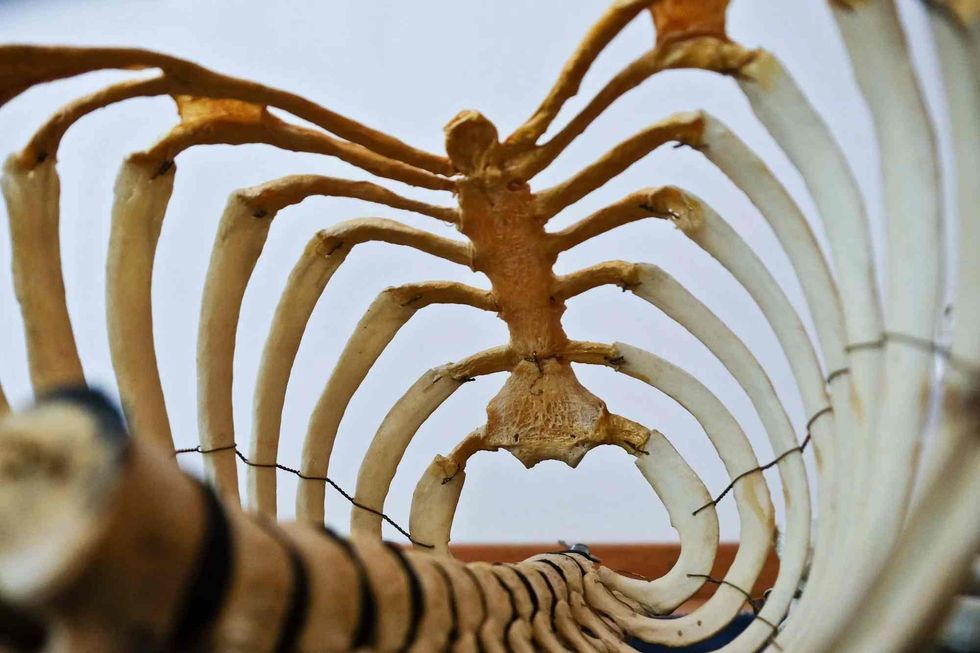The rib cage, along with the sternum, is commonly known as the thoracic cage.
What would happen if we didn't have a rib cage? Here are several reasons why we need a rib cage.
The rib cage is an arrangement of ribs attached to the vertebral column and the sternum in the thorax. Have you ever wondered how a skeletal system protects the organs?
Well, it is this bone structure of ribs that helps keep crucial organs like your heart, lungs, and liver safe in the thoracic cavity. It is the body's best defense against injury. The ribs' unique shape helps increase or decrease the thoracic cavity, helping the lungs in respiration.
Are you aware that it is not only humans that have a rib cage? Various other animals have a rib cage too. But do you know which animal has the most ribs? Snakes. A snake has about 200-400 vertebrae, each having a pair of ribs on either side, making it the animal with the most number of ribs.
In this article, you will come across various interesting facts about human anatomy and answers to all the questions you have!
If you are interested in reading fun facts about humans and the universe we live in, why not check out other articles like how many earths can fit in the sun? And, how many nerves are in the human body?
How many ribs does a woman have?
The humans' bony rib cage or the thoracic cage comprises 12 pairs of ribs, sternum, thoracic vertebrae, and cartilages with a three-layer muscle between the bones.
Most humans have about 24 ribs, 12 on each side arranged symmetrically. However, few people have an extra rib or a cervical rib pair. This complete structure of ribs forms the rib cage that protects vital organs such as the lungs and the heart.
Out of the 12 pairs of ribs, the first seven pairs are attached to the vertebrae with costal cartilages. These seven pairs are called true ribs. The ribs number 8-10 are connected to the vertebrae posteriorly.
They do not join the sternum anteriorly; hence they're called false ribs. These 8-10 ribs join the sternum through the costal cartilages of the above ribs. The eleventh and the twelfth rib pair do not join the sternum by costal cartilages or anything else.
These are known as floating ribs. These floating ribs have cartilages ending in the abdominal wall muscle, which only connect to the spine. So the human body has a total of four individual floating bones.
However, few people can be born with a ribcage having more than or less than 24 ribs. Supernumerary ribs are nothing but the extra ribs, and agenesis of the ribs is a condition wherein the ribcage has less than 24 ribs.
Although there is a misconception that women might have lesser ribs than men, there is no scientific evidence to support this. So, we can say people have the same number of ribs irrespective of their gender.
Do males or females have more bones?
Did you know? Some researchers state that cervical ribs - extra ribs - above the first rib are more common in women than men.
The cervical rib can also cause neck pain or numbness in the neck region, caused by the rib pressing down on the blood vessels. The cervical rib can also result in a condition called Thoracic Outlet Syndrome (TOS). TOS usually shows up and affects more adult men than women. However, not everyone with a cervical rib will develop TOS.
Do men or women have more bones? This is a common question with people. But the simple answer is no one. Male and female skeletal systems have the same number of bones, 206 bones.
Though, newborns have 300 bones that later fuse as they grow. A normal, healthy 11 year old should already have a complete set of ribs. But as the child keeps growing, it causes the development of the ribs to expand and form further by around 1-2 in (2.5-5 cm).
In comparison, your pet cat has about 13 pairs of ribs. And in fish, there are usually only two sets of ribs attached to the vertebral column.
But compared to the female skeletal system, the male skeleton is heavier and more prominent. Men have stronger bones and joint surfaces and more bone at the site where the muscle attaches. However, women have stronger pelvises for their distinct ability to carry a baby and experience childbirth.
What is the weakest bone in your body?

We know that human bones are extraordinarily strong. They are stronger than steel! But a few of our bones are a little weaker than the rest.
The weakest bone means the bone that can easily fracture. The clavicle or collarbone is the most fragile and softest bone and most likely to break and crack upon pressure or stress on the shoulders.
The femur is the strongest, longest, most prominent, and heaviest bone located in the thigh.
What's the strongest part of the human body?
The ribcage protects the lungs, heart, and various other internal organs of the thorax. This may indicate that the ribs are extremely strong.
But teeth enamel is probably the strongest part of our body. And as already mentioned before, the strongest bone is the femur. It is so strong due to its hard, sturdy design, placing the femur as the second most potent part of the body.
The most delicate part of your body is the eyeballs and the three tiny bones present in your ears.
Here at Kidadl, we have carefully created lots of interesting family-friendly facts for everyone to enjoy! If you liked our suggestions for How many ribs does a human have? Curious human body facts for kids! Then why not take a look at Is a penguin a mammal?
Here's why penguin is a flightless bird! Or How is paper made? Fascinating facts explained f









